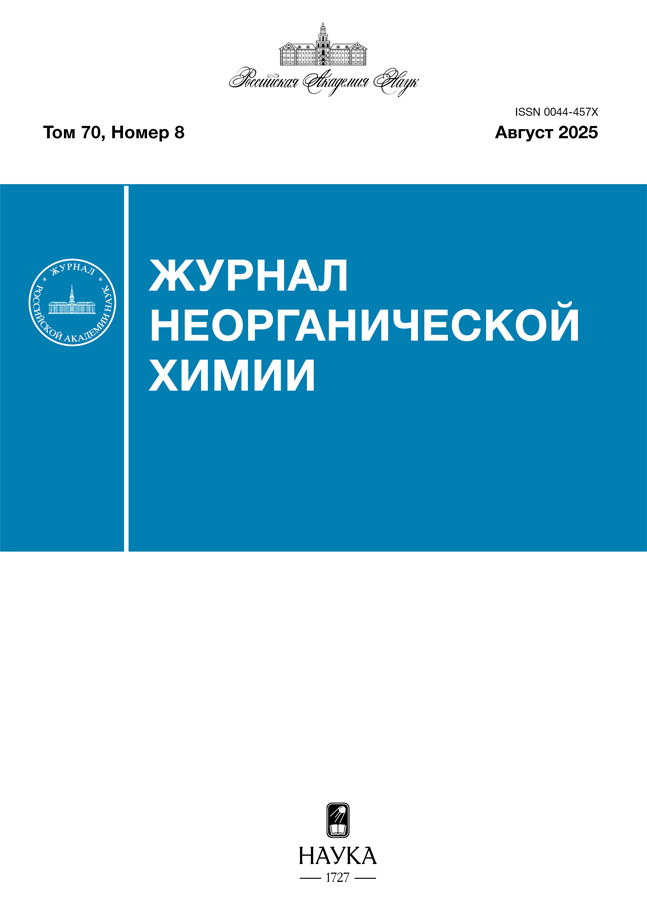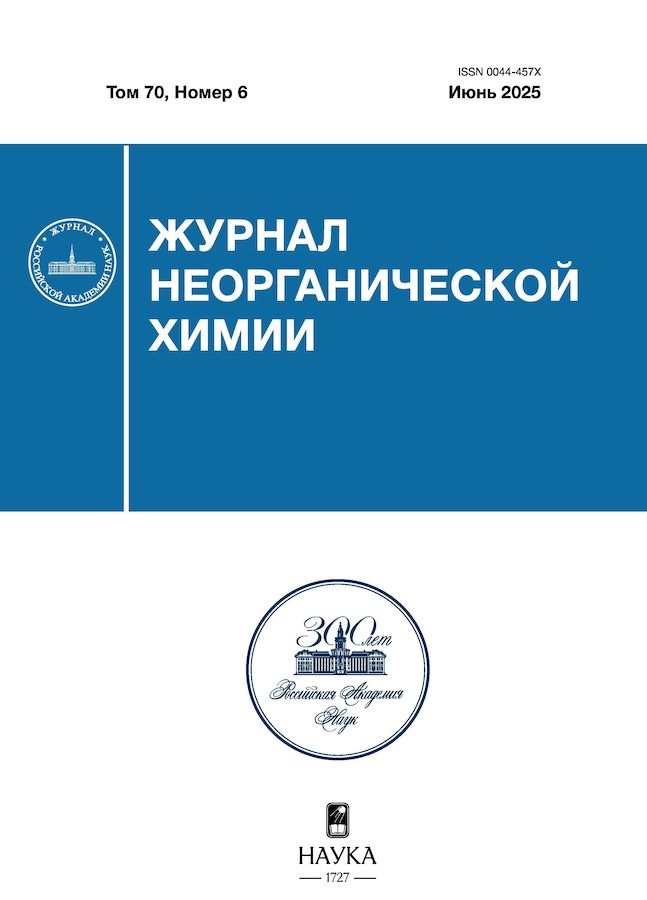Особенности комплексообразования кобальта(II) с азагетероциклическими лигандами в присутствии моногидроксизамещенного производного клозо-додекаборатного аниона
- Авторы: Матвеев Е.Ю.1,2, Никифорова С.Е.2, Кубасов А.С.2, Малинина Е.А.2, Жижин К.Ю.2, Кузнецов Н.Т.2
-
Учреждения:
- Институт тонких химических технологий им. М.В. Ломоносова МИРЭА – Российского технологического университета
- Институт общей и неорганической химии им. Н.С. Курнакова РАН
- Выпуск: Том 70, № 6 (2025)
- Страницы: 792-799
- Раздел: КООРДИНАЦИОННЫЕ СОЕДИНЕНИЯ
- URL: https://kazanmedjournal.ru/0044-457X/article/view/686393
- DOI: https://doi.org/10.31857/S0044457X25060074
- EDN: https://elibrary.ru/IBXXGP
- ID: 686393
Цитировать
Полный текст
Аннотация
Изучено комплексообразование кобальта(II) с азагетероциклическими лигандами L (L – 2,2ʹ-бипиридил (Bipy), 1,10-фенантролин (Phen), 2,2ʹ-бипиридиламин (BPA)) в присутствии моногидроксизамещенного производного клозо-додекаборатного аниона [B12H11OH]2–. В зависимости от природы используемого органического лиганда и условий синтеза получены и структурно охарактеризованы координационные соединения [CoIII(Bipy)2Cl2]2[B12H11OH], [CoII(Phen)3][B12H11OH] и [CoII(Bipy)3][B12H11OH] с кластерным анионом бора в качестве противоиона, а также смешаннолигандный комплекс [CoII(BPA)2Cl2] известного строения. Впервые для системы, содержащей кобальт(II) и замещенное производное кластерного аниона бора, наблюдается окислительно-восстановительная реакция на воздухе без введения дополнительных окисляющих агентов, приводящая к образованию комплекса кобальта(III).
Полный текст
Об авторах
Е. Ю. Матвеев
Институт тонких химических технологий им. М.В. Ломоносова МИРЭА – Российского технологического университета; Институт общей и неорганической химии им. Н.С. Курнакова РАН
Автор, ответственный за переписку.
Email: korolencko0110@yandex.ru
Россия, пр-т Вернадского, 86, Москва, 119571; Ленинский пр-т, 31, Москва, 119991
С. Е. Никифорова
Институт общей и неорганической химии им. Н.С. Курнакова РАН
Email: korolencko0110@yandex.ru
Россия, Ленинский пр-т, 31, Москва, 119991
А. С. Кубасов
Институт общей и неорганической химии им. Н.С. Курнакова РАН
Email: korolencko0110@yandex.ru
Россия, Ленинский пр-т, 31, Москва, 119991
Е. А. Малинина
Институт общей и неорганической химии им. Н.С. Курнакова РАН
Email: korolencko0110@yandex.ru
Россия, Ленинский пр-т, 31, Москва, 119991
К. Ю. Жижин
Институт общей и неорганической химии им. Н.С. Курнакова РАН
Email: korolencko0110@yandex.ru
Россия, Ленинский пр-т, 31, Москва, 119991
Н. Т. Кузнецов
Институт общей и неорганической химии им. Н.С. Курнакова РАН
Email: korolencko0110@yandex.ru
Россия, Ленинский пр-т, 31, Москва, 119991
Список литературы
- Zhao X., Yang Z., Chen H. et al. // Coord. Chem. Rev. 2021. V. 444. P. 214042. https://doi.org/10.1016/j.ccr.2021.214042
- Jin Y., Zhang W., Zhou Z. et al. // Fire Phys. Chem. 2022. V. 2. P. 236. https://doi.org/10.1016/j.fpc.2022.04.001
- Zhang Z., Zhao Z., Wang B., Zhang J. // Green Energy Environ. 2021. V. 6. P. 794. https://doi.org/10.1016/j.gee.2020.12.002
- Huang Z., Wang S., Dewhurst R.D. et al. // Angew. Chem. Int. Ed. 2020. V. 59. P. 8800. https://doi.org/10.1002/anie.201911108
- Cabrera-González J., Chaari M., Teixidor F. et al. // Molecules. 2020. V. 25. P. 1210. https://doi.org/10.3390/molecules25051210
- Corona-López M.M., Muñoz-Flores B.M., Chaari M. et al. // Eur. J. Inorg. Chem. 2021. V. 2021. P. 2047. https://doi.org/10.1002/ejic.202100144
- Zhang Z., Gabel D., Assaf K.I., Nau W.M. // Org. Lett. 2022. V. 24. P. 9184. https://doi.org/10.1021/acs.orglett.2c03615
- Meng Y., Lin X., Huang J., Zhang L. // Molecules. 2024. V. 29. P. 3916. https://doi.org/10.3390/molecules29163916
- Chen C., Chen Z., Zhang M. et al. // Chem. Sus. Chem. 2023. V. 16. P. e202300434. https://doi.org/10.1002/cssc.202300434
- Sun W., Jin Y., Wu Y. et al. // Inorg. Chem. Front. 2022. V. 9. P. 5140. https://doi.org/10.1039/D2QI00890D
- Wang L., Jiang T., Duttwyler S., Zhang Y. // Cryst. Eng. Comm. 2021. P. 23. P. 282. https://doi.org/10.1039/D0CE01395A
- Xu H., Liu J., Li R. et al. // Coord. Chem. Rev. 2024. V. 511. P. 215795. https://doi.org/10.1016/j.ccr.2024.215795
- Cebula J., Fink K., Boratyński J., Goszczyński T.M. // Coord. Chem. Rev. 2023. V. 477. P. 214940. https://doi.org/10.1016/j.ccr.2022.214940
- Hattori Y., Ishimura M., Ohta Y. et al. // ACS Med. Chem. Lett. 2022. V. 13. P. 50. https://doi.org/10.1021/acsmedchemlett.1c00377
- Imperio D., Panza L. // Symmetry. 2022. V. 14. P. 182. https://doi.org/10.3390/sym14020182
- Teixidor F., Núñez R., Viñas C. // Molecules. 2023. V. 28. P. 4449. https://doi.org/10.3390/molecules28114449
- Matveev E.Yu., Avdeeva V.V., Zhizhin K.Yu. et al. // Inorganics. 2022. V. 10. P. 238. https://doi.org/10.3390/inorganics10120238
- Peymann T., Knobler C.B., Hawthorne M.F. // Inorg. Chem. 2000. V. 39. P. 1163. https://doi.org/10.1021/ic991105
- Malinina E.A., Kubasov A.S., Matveev E.Yu. et al. // Polyhedron. 2023. V. 242. P. 116516. https://doi.org/10.1016/j.poly.2023.116516
- Semioshkin A.A., Petrovskii P.V., Sivaev I.B. et al. // Russ. Chem. Bull. 1996. V. 45. P. 683. https://doi.org/10.1007/BF01435806
- Bruker, SAINT, Bruker AXS Inc., Madison, WI, 2018.
- Krause L., Herbst-Irmer R., Sheldrick G.M., Stalke D. // J. Appl. Crystallogr. 2015. V. 48. № 1. P. 3. https://doi.org/10.1107/S1600576714022985
- Sheldrick G.M. // Acta Crystallogr., Sect. C: Struct. Chem. 2015. V. 71. P. 3. https://doi.org/10.1107/S2053229614024218
- Dolomanov O.V., Bourhis L.J., Gildea R.J. et al. // J. Appl. Crystallogr. 2009. V. 42. P. 339. https://doi.org/10.1107/S0021889808042726.
- Queyriaux N., Abel K., Fize J. et al. // Sustainable Energy Fuels. 2020. V. 4. P. 3668. https://doi.org/10.1039/D0SE00570C
- Avdeeva V.V., Vologzhanina A.V., Goeva L.V. et al. // Inorg. Chim. Acta. 2015. V. 428. P. 154. https://doi.org/10.1016/j.ica.2014.12.029
Дополнительные файлы
















